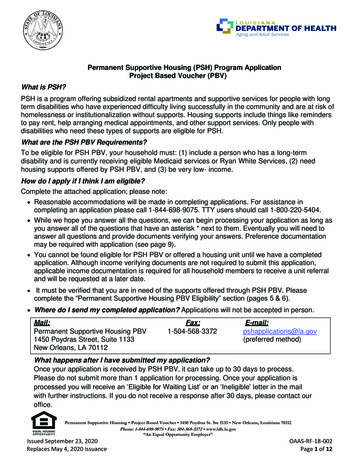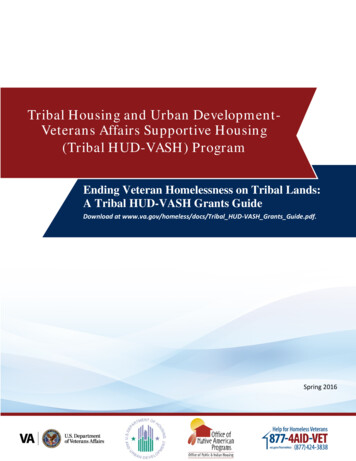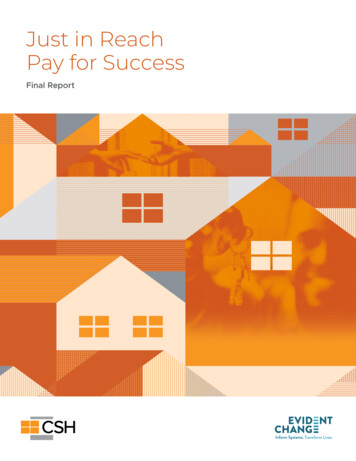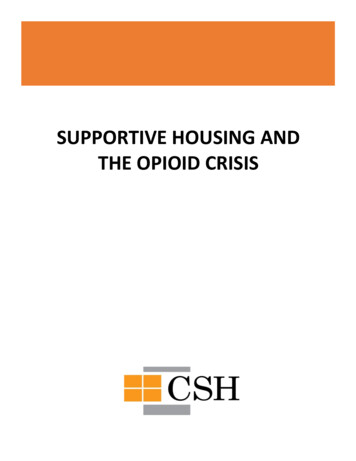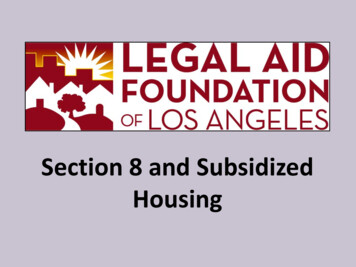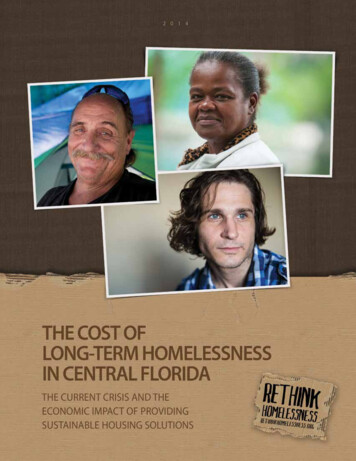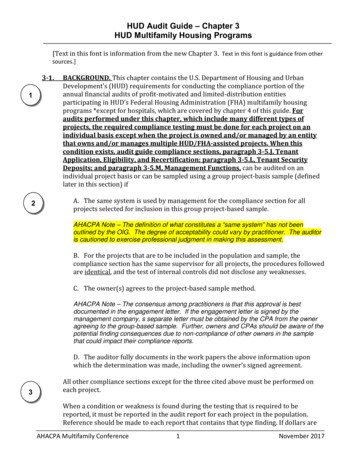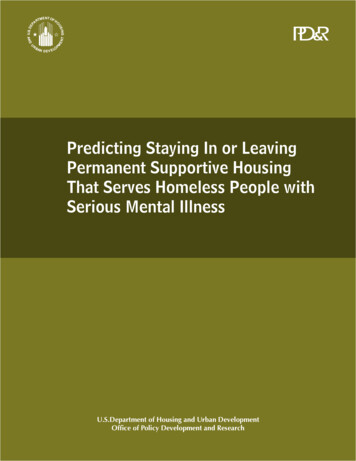
Transcription
Predicting Staying In or LeavingPermanent Supportive HousingThat Serves Homeless People withSerious Mental IllnessU.S.Department of Housing and Urban DevelopmentOffice of Policy Development and Research
Predicting Staying in or LeavingPermanent Supportive HousingThat Serves Homeless People withSerious Mental IllnessFinal ReportPrepared for:U.S. Department of Housing and UrbanDevelopmentOffice of Policy Development andResearchPrepared by:Yin-Ling Irene Wong, CMHPSRTrevor R. Hadley, CMHPSRDennis P. Culhane, CMHPSRSteve R. Poulin, CMHPSRMorris R. Davis, MDACBrian A. Cirksey, MDACJames L. Brown, MDACM. Davis and Company, Inc (MDAC)Philadelphia, PAUniversity of PennsylvaniaCenter for Mental Health Policy and Services Research(CMHPSR)Philadelphia, PAMarch 2006
ACKNOWLEDGEMENTSMany individuals and organizations have contributed to the completion of this project.We would especially like to thank the following: The City of Philadelphia’s Office of Public Health’s Institutional Review Board. The staff and managers of the City of Philadelphia’s Department of BehavioralHealth/Mental Retardation Services. The residential support staff, case managers and supervisors of the city’spermanent housing programs who tirelessly serve the city’s homeless andmentally ill populations. Our advisory team members, Carol Caton and Michale Covone who havecontributed their time, knowledge and expertise. Paul Dornan, our project Government Technical Representative from the U.S.Department of Housing and Urban Development (HUD)’s Office of PolicyDevelopment and Research (OPDR), for providing us with indispensable support,insights and encouragement throughout the study. Additionally, Kevin Neary,also from HUD’s OPDR, provided invaluable support.We appreciate the significant contributions that the above individuals made to theimplementation of the research project and writing of this report. They are notresponsible for any errors or omissions. The findings and views herein are those ofthe contractors and authors.The contents of this report are the views of the contractor and do not necessarilyreflect the views or policies of the U.S. Department of Housing and UrbanDevelopment or the U.S. Government.
ForewordThe Permanent Housing component of the Supportive Housing Program, theDepartment’s principal program to meet the needs of homeless people with disabilities,was established to offer homeless people with disabilities, including mental illness, anassurance of permanent housing and appropriate supportive services. The program isdesigned to provide a structure that counteracts the disruptions of both homelessness anddisability. However, while many formerly homeless people remain in permanentsupportive housing for many years, substantial numbers leave within months of entry.The questions of why people leave permanent housing and what happens to themconstitute the principal focus of this study.This study examines the experience of some 943 residents of permanent supportivehousing in Philadelphia during the period from 2001 to 2005. The capability to mergeHomeless Management Information System (HMIS) data and administrative data inPhiladelphia, Pennsylvania, made possible a viable strategy to track over time a highlyelusive population -- formerly homeless people with mental illness who had leftpermanent supportive housing.The study shows that it is not necessarily a bad thing that some people leave “permanent”supportive housing. Those who left and the circumstances of their departure were highlydivergent, and who left and how was significantly related to the stability of their housingand the independence of their lives, both in the short- and longer-term. Three-fifths ofthose who left HUD-supported Permanent Housing in Philadelphia left voluntarily, eitherto pursue better housing or to move away from problems they were experiencing in thepermanent supportive housing. The remaining two-fifths left involuntarily, having beenasked to leave because they violated program rules or because they were adjudged bystaff incapable of maintaining themselves in the permanent supportive housingenvironment. Those who left under positive circumstances were far more likely to moveto more stable and independent housing, to stay in that housing over time and to usefewer mental health services post-departure than those who left more negatively. Thestudy also found that, based on the variables included, there would have been no way topredict at entry into permanent supportive housing who would stay or leave, eitherpositively or less so.This study makes a valuable contribution to our understanding of how the structure ofpermanent supportive housing and the use of various means of stabilization at criticaljunctures in a resident’s stay can promote more stability and, thereby, greater health andindependence, among those living there, whether they stay or subsequently leave.Darlene F. WilliamsAssistant Secretary forPolicy Development and Research
TABLE OF CONTENTSACKNOWLEDGEMENTS IIEXECUTIVE SUMMARY . .VIIBackground .viiMethod ixFindings .ixHousing Tenure of Permanent Housing Residents .xDifferences between Those Who Leave Permanent Housing and Those Who Stay . .xiCategories of Those leaving HUD- Funded Permanent Housing .xiCircumstances of Departure from HUD-Funded Permanent Housing .xiiiPost-Permanent Housing Residential Careers of Leavers .xvImplications and Recommendations .xvCHAPTER 1: INTRODUCTION AND OVERVIEW OF THE STUDY .1Introduction . .1Background . .2HUD-Assisted Permanent Housing . .2Limited Length of Stay for Participants of Permanent Housing Programs 3Characteristics Associated with Housing Instability and Leaving PermanentHousing .5Research Questions .5Study Site Selection 6The Rest of this Report .7CHAPTER 2: METHODS 9Introduction .9Retrospective Tracking of Leavers and Stayers of Permanent Housing through theIntegrated Longitudinal Administrative Database .9Selection of the Retrospective Tracking Sample . 9The Integrated Longitudinal Administrative Database 10Data Quality Issues of Longitudinal Integrated Database .11Data Analysis .11Prospective Tracking of Leavers and Stayers of Permanent Housing ThroughInterviews .12Initial Contact with Permanent Housing Programs .12Recruitment of the Leaver Sample .12Information Collected at Baseline and Follow-Up Conversations with PermanentHousing Leavers .13Tracking Strategy Used to Increase Retention of Permanent Housing Leavers .14Recruitment of the Stayer Sample .14Information Collected at Interviews with Permanent Housing Stayers .15Challenges the Project Faced in Participant Recruitment and Tracking .15iii
Participation and Refusal Rates of Leavers and Stayers (Baselines) .16Consumer Background Form Filled by Residential Support Staff .17CHAPTER 3: CHARACTERISTICS OF PERMANENT HOUSING PROGRAMSFOR PERSONS WITH SERIOUS MENTAL ILLNESS IN PHILADELPHIA,PENNSYLVANIA 19Introduction 19Background of the Study Site: Mental Health Services and Permanent Housing .20Public Mental Health Services in Philadelphia .20Permanent Housing Programs for Persons with Serious Mental Illness .21Characteristics of Permanent Housing for Persons with Serious Mental Illness .23Definition of Permanent Housing Programs . 24Sources of Housing Subsidy . 26Ownership of Housing Units 26Neighborhood Characteristics of Housing Units . 27Residential Support Services Characteristics 28Housing Preference of Permanent Housing Residents . 29Departures from Permanent Housing: Incidence and Timing . .31Incidence of Discharges from and Admissions to Permanent Housing (EntireRetrospective Sample) . 31Types of Discharges from Permanent Housing . .32Timing of Discharges from Permanent Housing for a Sub-sample of Three EnteringCohorts . 33Summary 34CHAPTER 4: LEAVING PERMANENT HOUSING -CIRCUMSTANCESOF LEAVING AND THE POST-PERMANENT HOUSING CAREERS OFLEAVERS .37Overview 37Circumstances of Leaving .38Destinations of Departure from Permanent Housing and Living Situation UponDeparture 38Identification of Subgroups of Leavers – Voluntary and Involuntary Leavers .39Comparison of Voluntary and Involuntary Leavers .40Scenarios of Leaving .43Post-Permanent Housing Careers of Leavers 46Aggregate Profile of the Post-Permanent Housing Careers of Leavers 47Post-Permanent Housing Careers of Voluntary Leavers and Involuntary Leavers .49Summary .54CHAPTER 5: FACTORS ASSOCIATED WITH LEAVING PERMANENTHOUSING .55Overview 55Categories of Leavers 55Factors Associated with Leaving and Staying in Permanent Housing- RetrospectiveTracking Sample . 58iv
Socio-Demographic and Diagnostic Characteristics .58Stay History in Homeless Shelter . .59Service-Use Characteristics – Medicaid (CBH) 61Service-Use Characteristics – Community Reporting System (CRS) . 62Program Characteristics .64Identification of Predictors of Leaving and Staying Using Multivariate Analysis. 65Factors Associated with Leaving and Staying in Permanent Housing- ProspectiveTracking Sample .68Comparison of Socio-Demographic Characteristics between Leavers and Stayers. 69Comparison of Other Individual Characteristics between Voluntary Leavers,Involuntary Leavers, and Stayers .69Levels of Skills in Independent Living and Extent of Support and Services .70Summary 71CHAPTER 6: SUMMARY, IMPLICATIONS AND RECOMMENDATIONS. .73Overview . .73Summary Findings . 74Characteristics of Permanent Housing . . 74Circumstances of Leaving . 75Factors Associated with Leaving Permanent Housing and Post-Permanent Careers 75Implications and Recommendations . 76APPENDIX A: GLOSSARY . A.1APPENDIX B: REFERENCES B.1APPENDIX C: LEAVER DISCUSSION GUIDE . .C.1APPENDIX D: LEAVER FOLLOW-UP DISCUSSION GUIDE. .D.1APPENDIX E: STAYER DISCUSSION GUIDE . E.1APPENDIX F: LEAVER/STAYER CONSUMER BACKGROUNDWORKSHEET .F.1LIST OF TABLESTable 3.1:Table 3.2:ABTable 3.3:Table 3.4:Table 3.5:Capacity, Occupancy, Housing Subsidy and Homelessness .25Current Living Situation and Preferred Living SituationWith Other Mental Health Consumers . .30With Family Members . 30Data on Current Residents, Admissions and Discharges .32Types of Permanent Housing Discharges . 33Patterns of Discharge for Three Entering Cohorts . 34v
Table 4.1:Table 4.2:Table 4.3:Table 4.4:Table 5.1:Table 5.2:Table 5.3:Table 5.4:Table 5.5:Table 5.6:Table 5.7:Table 5.8:Table 5.9:Table 5.10:Current Residence and Living Situations at Baseline Interview AfterLeaving Permanent Housing . 38Comparison of Attributes of Voluntary and Involuntary Leavers .41Post-Permanent Housing Careers of Leavers- Current Residence& Living Situations . . 47Post-Permanent Housing Service Use Patterns of Leavers .49Categorization of Leavers .56Socio-demographic, Diagnostic and Functioning Characteristics .59Stay History in Homeless Shelter .60Service Use Characteristics (Medicaid- CBH) .62Service Characteristics (Community Rehabilitation Services- CRS). 63Program Characteristics .65Multinomial Logistic Regression Results Predicting Positive Leaving,Non-Positive Leaving, and Staying in Permanent Housing .67Socio-demographic Characteristics Matched in the Study Design 69Other Individual Characteristics .70Level of Functioning and Extent of Support and Services .71vi
EXECUTIVE SUMMARYBackgroundOne principal assumption underlay the Permanent Housing component when Congressestablished the Supportive Housing Demonstration Program (and its successor, the SupportiveHousing Program) in the Stewart B. McKinney Act: That the combination of permanentcommunity-based housing and the provision of ongoing supportive services to homeless peoplewith disabilities would foster among individuals of that difficult-to-serve population the greatestindependence or self-sufficiency possible. A similar concept underlies the Shelter Plus Care(S C) program established by the National Affordable Housing Act of 1990. The purpose ofS C was to “provide rental housing assistance, in connection with supportive services fundedfrom other sources other than this subtitle, to homeless persons with disabilities (primarilypersons who are seriously mentally ill, have chronic problems with alcohol, drugs, or both, orhave acquired immunodeficiency syndrome and related diseases) and the families of suchpersons.” The third programmatic HUD McKinney-Vento Act permanent housing alternative,although not specifically targeted to a disabled homeless population, does serve a highproportion of homeless people with serious mental illness; in 2001, for example, roughly a thirdof all adults entering HUD-supported Single Room Occupancy (SRO) units were mentally ill.Permanent housing has remained a major focus of the Department’s programs that specificallyserve homeless people with disabilities. The combined funding for HUD McKinney-Vento Actprograms (including the Emergency Shelter Grant (ESG), Supportive Housing, S C andSection 8 SRO programs) that contain no limits on length of stay, S C, Section 8 SRO and thePermanent Housing component of the Supportive Housing Program, has over the lives of thoseprograms made up approximately a third of all funding ( 3.2 billion of 9.8 billion). Althoughthe proportion of funding going to these three permanent housing programs has variedconsiderably from year to year, ranging from 17 percent in 1997 to 70 percent in 1993, theDepartment has responded to clear Congressional direction to keep the permanent housing optionat the forefront of HUD’s homeless efforts, and approximately 45 percent of its funding effort(including the non-competitive and short length of stay ESG program) went to permanenthousing in FY 2004.Yet there is considerable difference between the presumption of long-term housing andsupportive services as the key to moving homeless people with disabilities toward the greatestself-sufficiency of which they are capable and the realities of length of stay in HUD-assistedpermanent housing for homeless people with disabilities. For example, according to the AnnualProgress Report (APR), the annual reporting document for HUD-funded competitive homelessprograms, about five percent of all adult participants of HUD-funded permanent housing for thehomeless (including the Permanent Housing Program, the S C Program and the Section 8 SROProgram) during program year 2004 left within the first two months after entry; another sevenpercent left in the period from three to six months; and altogether about a quarter of allvii
Permanent Housing beneficiaries throughout that year left after two or fewer years in thepermanent housing setting. For some significant number of homeless people with disabilities,McKinney Act-supported permanent housing is apparently not experienced as permanent.When the homeless providers who are recipients of HUD homeless funding reported, whereknown, the destination of adult participants who departed permanent housing, 23 percent werereported as going directly to market-rate rental housing, 29 percent to subsidized rental housingand one percent to homeownership situations. On the other hand, there was a sizable proportionwhose destinations were less propitious. For example, 20 percent were moving in, eitherpermanently or on an interim basis, with families or friends; ten percent were going tojail/prison, a psychiatric hospital or an inpatient alcohol or drug treatment facility; three percentdeparted for transitional housing, three percent to emergency shelters and one percent back to thestreet.These figures raise very important policy questions for the Department in its administration of itspermanent housing programs for homeless persons. For example:1. What does permanent housing mean for homeless providers and clients? What givesHUD-funded permanent housing its distinctive character, if anything? Or is it simply aform of housing that permits long-term residency but in practice looks like transitionalhousing but for a narrower eligible population?2. What happens to the formerly homeless people with disabilities who leave HUD-fundedpermanent housing? How do they differ from those who remain in the HUD-fundedpermanent housing? Why do those who depart leave? Where do they go? How do theyfare? What happens to them over time? What do their post-permanent housingresidential careers look like?3. How does the degree and nature of disability and the length of time without housing atthe time participants enter permanent housing affect how long they remain in thepermanent housing, where they go upon departure and housing stability after leavingpermanent housing? Do people who leave permanent housing voluntarily havesignificantly different residential careers after permanent housing than those who leaveinvoluntarily? Does length of stay in permanent housing affect significantly theresidential careers of residents of permanent housing after they leave that housing? Doesthe composition of the services offered and the timeframe within which the services areprovided in the permanent housing affect significantly the residential careers ofpermanent housing leavers once they depart that housing?This research is primarily but not exclusively about homeless people with serious mental illness.It is clear that early availability of HUD McKinney Act funding for permanent supportivehousing coincided with actions by the City of Philadelphia and the State of Pennsylvania to closePhiladelphia State Hospital in the early 1990s and to restructure public mental health care in thecity (See Chapter 3). Philadelphia has since been markedly successful in capturing SupportiveHousing and S C Program dollars for permanent supportive housing, 92 million from 1987 to2004. Moreover, the 28 permanent housing providers involved in this study reported that moreviii
than 60 percent of their current residents had previously been homeless, and ten of thoseproviders reported that 70 percent or more of their current clients had been homeless prior toentry. However, the administrative data upon which a significant part of the analysis is baseddoes not identify permanent housing residents by source of funding. As such, this study and itsfindings pertain to permanent housing in general in Philadelphia and do not necessarily representHUD McKinney Act permanent housing projects. In effect, we are constrained in our ability toisolate the formerly homeless mentally ill population from the larger group of lower incomementally ill population for much of the analysis.MethodIn 2002, the Department of Housing and Urban Development’s Policy Development and ResearchOffice contracted with M. Davis and Company, Inc. and University of Pennsylvania’s Center forMental Health Policy and Services Research to undertake a research project to help answer thesequestions. Philadelphia was selected as the study site, in part, because it has one of the mostcomprehensive Homeless Management Information Systems (HMIS) in operation in the nation.In addition, the University of Pennsylvania has developed a strong and continuing workingrelationship with the City and the State of Pennsylvania that permits analysis of longitudinaladministrative data for individuals served by, among others, the health, mental health, welfare andcriminal justice systems of the City, County and State.The HMIS enabled the study to incorporate a multi-modal tracking strategy. The strategy includedtwo components: (1) retrospective tracking of 943 mentally ill individuals who ever stayed inpermanent housing between January 1, 2001 and July 15, 2004, using an integrated longitudinaladministrative database, and (2) prospective tracking via interviews of 100 leavers who leftpermanent housing from February, 2003 to December, 2004 and a matched sample of 96 stayerswho were current permanent housing residents as of January, 2005. The selection of both theretrospective and prospective samples was designed to maximize the use of the integratedlongitudinal database available at the study site and facilitate a workable strategy to trackpermanent housing leavers over an 18-month or greater period and to secure reliable informationon post-permanent housing residential careers. The study also included interviews withpermanent housing support team providers, and secondary data analysis of a survey of permanenthousing residents and support team providers, funded by the National Institute of Mental Health(NIMH).FindingsPermanent housing embraces a variety of approaches that differ in housing and servicecharacteristics. When referencing characteristics of permanent housing, it is important to includeor, minimally, be aware of, the characteristics of importance to residents, features such ascondition/maintenance and location of the residence, staff involvement/relationship withresidents and presence of “problem/non-compliant” tenants. These “characteristics” aresubjective, particularly the latter two; however, they are of clear significance to tenants. Theunifying feature of permanent housing is the provision of housing subsidy with no stay limitix
attached to program participation. Although we can conclude that permanent housing is a longterm housing arrangement for a significant portion of permanent housing residents, it is evidentlynot a “permanent” housing arrangement for many others. In fact, many permanent housingresidents do not expect that their residency in permanent housing will be permanent.For leavers who have favorable post-permanent housing careers their limited tenure in permanenthousing could be interpreted as a positive outcome. These leavers have moved to livingsituations that require more independence than permanent housing. In essence, they are on atrack to be permanently off the street and integrated into the community. However, there is adiscernible proportion of leavers for whom permanent housing is neither a long-term solution norassists them in reaching a long-term solution. Clearly, for these homeless persons permanenthousing is not the end of their distress because they leave and go to unstable or less positivehousing settings or return to the street. This study will help to better understand why this isoccurring, what characteristics of the permanent housing or participants lead to leaving and whatshape the lives of leavers take once they depart permanent housing.Housing Tenure of Permanent Housing ResidentsAlthough it may be said that permanent housing for homeless people with disabilities is a longterm housing arrangement for a significant portion of permanent housing residents, this studysuggests it is not a “permanent” housing arrangement for everyone. Analysis of three permanenthousing entry cohorts between 2001 and 2003 in Philadelphia indicates that a significant portionof residents entering permanent housing at the same time left before two years of residence. Ifthe discharge patterns of the 2001 cohort were representative of all permanent housing residents,then we may expect that only half of those entering permanent housing would be able to keeptheir residency for three years or more. More than ten percent, in fact, left within six months,and nearly a quarter left within the first year after entry. There is no basis upon which to adjudgethe length of stay of study cohorts in Philadelphia different than that of permanent supportivehousing residents elsewhere.It is also noteworthy that the experience of leaving permanent housing is not limited to thosewho have relatively short tenure in permanent housing. Indeed, leaving also happened amongpermanent housing residents who might be considered most stably housed, that is, individuals inthe same permanent housing program for many years. In illustration, 41 percent who hadentered permanent housing units in the city before 1999 left in the period between 2001 and2003.Leaving, it should be noted, may not be an adverse outcome; for some clients, leaving is adesirable event that leads to better housing or to a higher level of independence and selfsufficiency. For example, over 18 percent of those discharged during the three years of the studyreported as living independently and alone. Another three percent were living with a spouse or asignificant other.x
Differences between Those Who Leave Permanent Housing and Those Who StayFindings from the integrated longitudinal data identify no differences between leavers andstayers along major demographic attributes, including age, gender, race/ethnicity, psychiatricdiagnosis, substance treatment history and level of functioning as rated by the GlobalAssessment of Functioning (GAS) scale – a simple standardized rating scale of the currentoverall level of functioning of the client. Moreover, characteristics of permanent housingprograms measured at the residential support team level, including program size (capacity) andprovider-assessed level of functioning and intensity of support, are not associated with leaverstayer status.In contrast, individual behavioral health services use, particularly service use during participants’stays in permanent housing, emerges as a key factor predicting leaving and staying in permanenthousing. Specifically, leavers as a group are more likely than stayers to have experiencedinpatient mental hospital admissions, more likely to have used community residential services,and more likely to have used emergency services during their tenure in permanent housing.Stayers, on the other hand, had more contact with community residential services prior topermanent housing entry and more contact with outpatient services during their permanenthousing stay. The significantly higher incidence of psychiatric hospitalization and emergencyservices use among leavers could be indicative of the deteriorating status of mental health amongleavers after entering permanent housing. Experiences of relapses may be an important factorcontributing to the inability of some permanent housing residents to continue their tenure inpermanent housing.Categories of Those Leaving HUD-Funded Permanent HousingFurnished with information about the whereabouts of leavers in both the integrated longitudinaldata and the interview data, we distinguished between two subgroups of leavers. In summary,one-third of the leavers are designated as “positive leavers” who left permanent housing to go toindependent and other living arrangements (such as with family and friends)1 that are notassociated with professional residential support, and two-thirds are designated as “non-positive”leavers who left permanent housing to go to congregate residential settings (in general, a moreintensive residential support than permanent housing), institutional settings (hospitals andcorrectional institutions), homelessness, and other unspecified whereabouts. This finding isbased on the “discharge codes” assigned in the administrative data at the point of departure.1We acknowledge throughout this report that departing to family and friends is characterized as a positive departurein some results and non-positive in others. Use of variant data sources has necessitated more ambiguity in thisregard than certainly is preferable. Departure to family and friends can represent a very temporary circumstance forsome and a permanent solution for others. For some formerly homeless people with serious mental illness, therelative independence of moving in with family and friends is a sign of capacity; for others, it may be anacknowledgement of dependence. Differing data elements and presumptions of the various data sources used in thisreport do not always allow us to make those kinds of distinctions. We do, however, indicate in each instance whatdeparture to family and friends means with that context.xi
Similarly, based on the reports of leavers and residential support staff in the interview data, wefound two major subgroups of leavers: voluntary leavers (61%) and involuntary leavers (39%).Voluntary leavers are residents who elected to leave permanent housing to either pursue betterhousing or to move away from problems they experienced at their current permanent housingprogram. Involuntary leavers are residents who have been asked to leave the permanent housingbecause they violated program rules, such as drinking
independence or self-sufficiency possible. A similar concept underlies the Shelter Plus Care (S C) program established by the National Affordable Housing Act of 1990. The purpose of S C was to "provide rental housing assistance, in connection with supportive services funded
